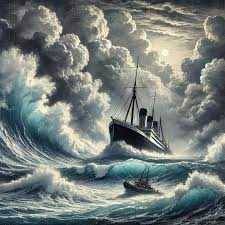The Drake of passage
The “Drake Passage†is a legendary, turbulent stretch of ocean located between the southern tip of South America and Antarctica. Spanning approximately 500 miles, it connects the Atlantic and Pacific Oceans and is infamous for its extreme weather, powerful currents, and unpredictable seas. Named after the English explorer Sir Francis Drake, this passage is a major route for ships heading to the icy continent and is often regarded as one of the most challenging crossings in the world.
Historically, the Drake Passage has been a key part of human exploration and marine navigation. In the 16th century, when European explorers first encountered the passage, it marked a significant milestone in the age of exploration. Sir Francis Drake was one of the earliest explorers associated with the passage, though he never actually traversed it. His ship, the Golden Hind, was forced southward towards what is now the Drake Passage due to rough weather while navigating the Strait of Magellan. After this incident, sailors began to realize that the vast waters below South America offered an alternative route between the Atlantic and Pacific, though few dared to cross it due to its dangers.
The Drake Passage's notoriety arises from its position between two massive bodies of water, with no major landmass to act as a barrier. Here, the powerful Antarctic Circumpolar Current flows unobstructed, moving over 135 million cubic meters of water per second from west to east. This massive current is the primary reason for the passage's infamously rough seas. The currents interact with powerful westerly winds known as the "Roaring Forties" and "Furious Fifties," which amplify wave heights, often creating swells of up to 30 feet or more. As a result, the passage is one of the most volatile maritime regions, posing challenges for even the most experienced sailors and modern vessels.
In recent times, the Drake Passage has also become an important route for scientific and tourist expeditions to Antarctica. Each year, thousands of researchers, scientists, and tourists cross the passage to reach Antarctica, drawn by the continent's unique wildlife and ecosystems. However, the crossing is not for the faint-hearted, as the passage’s turbulent waters can turn a ship’s journey into a daunting experience. For many travelers, the journey through the Drake Passage is a "rite of passage," as it tests both physical endurance and mental resilience.
One of the most striking aspects of the Drake Passage is its incredible biodiversity. The frigid waters of the passage are home to a variety of marine life, including orcas, humpback whales, albatrosses, and seals. The nutrient-rich currents support a vibrant ecosystem, attracting diverse species that thrive in these cold, deep waters. The abundance of krill, a small shrimp-like creature, serves as a primary food source for many of these animals, making the passage a vital link in the Antarctic food chain. This biodiversity makes the passage a focal point for researchers studying marine life and the effects of climate change on polar ecosystems.
The Drake Passage also plays a significant role in regulating Earth’s climate. Its powerful currents contribute to the global conveyor belt of ocean circulation, which helps distribute heat and regulates temperatures across the planet. The cold waters absorb large amounts of carbon dioxide from the atmosphere, playing a crucial role in mitigating global warming. Scientists studying the passage aim to better understand these processes and their implications for climate change, emphasizing the need to protect this unique marine environment.
For travelers, crossing the Drake Passage offers an intense yet rewarding experience. Ships navigating the passage face extreme conditions, but the journey also provides an opportunity to witness some of the world’s most pristine and awe-inspiring landscapes. Icebergs, endless ocean vistas, and the sight of distant glaciers and mountains make the journey unforgettable. Many who complete the crossing describe it as a transformative experience, filled with moments of awe and introspection.
In conclusion, the Drake Passage remains one of the world’s last wild frontiers, a place where nature reigns supreme and human efforts to traverse it are continuously tested. Its strategic importance, ecological significance, and role in global climate regulation underscore its value and the need for conservation efforts. While the passage continues to challenge and captivate, it also serves as a reminder of the power and beauty of Earth’s most extreme environments. Whether for science, adventure, or sheer wonder, the Drake Passage stands as an emblem of nature’s untamed majesty.


